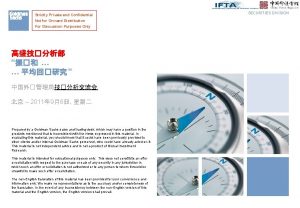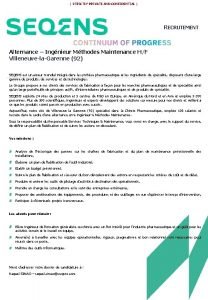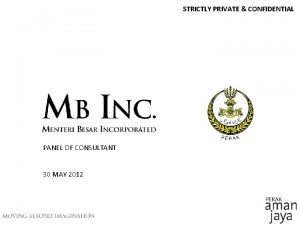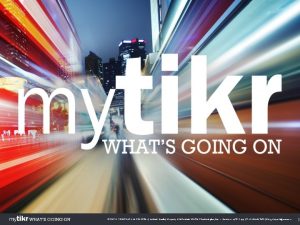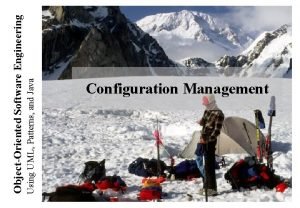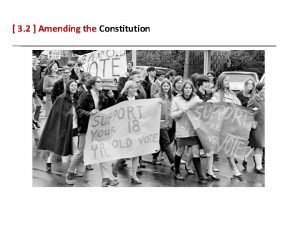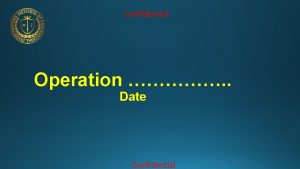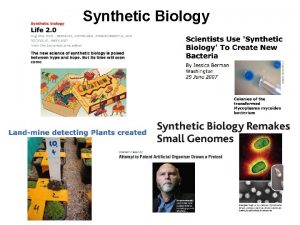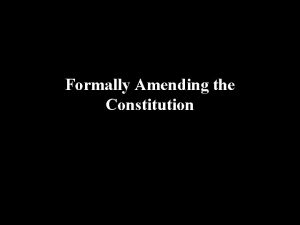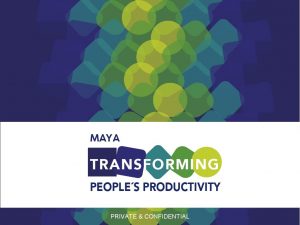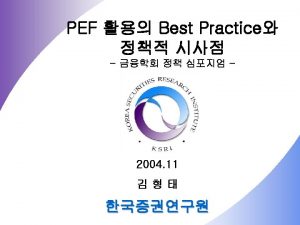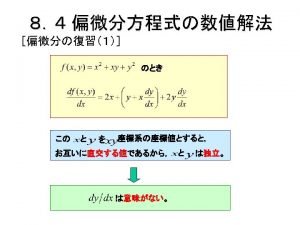Formally Private Synthetic Data Empowering research on confidential














- Slides: 14

Formally Private Synthetic Data: Empowering research on confidential data while providing for privacy and security April 2017 Simson L. Garfinkel Center for Research on Disclosure Avoidance DISCLAIMER: The views expressed in this presentation are those of the author and do not necessarily reflect the policy of the US Census Bureau, the US Department of Commerce, or the United States Government.

High-quality data can help accelerate empirical research in cancer and other areas. With high-quality data, we can: § Perform large-scale retrospective studies. § Identify drugs that may be highly effective in select populations. § Discover populations that have been excluded from the benefits of research. High-quality data requires high-quality privacy protection! § HIPAA limits the ability to share data with identifiers. § HIPAA privacy protections may be insufficient for community acceptance. § There may be additional issues resulting from the Common Rule. 2

Options for Research on Confidential Data 1 – Remote Stats Statisticians who want access to the data Organization with confidential data 1. Statistician goes to organization, does research, results are processed with disclosure avoidance and returned. Advantage: Stats run on the real data. Disadvantage: Slow; expensive; privileged statisticians. 3

Options for Research on Confidential Data - Microdata Statisticians who want access to the data Organization with confidential data 1. Organization publishes de-identified microdata. Advantage: Statistician can use data at their own offices. Results do not need disclosure avoidance. Disadvantage: Accuracy may be insufficient — and you can’t tell what’s not accurate. De-identified data may still leak sensitive information! 4

Options for microdata: de-identification De-identified microdata: § Direct Identifiers: Remove § Quasi-Identifiers: Generalize / suppress / infuse noise / swap § Data accuracy: degrades. Problems: § De-identification can be incomplete. § Impact on accuracy is frequently not released. 5

Options for microdata: synthetic data Partially synthetic: Sample an existing dataset and add noise. § Similar to de-identification § May not have strong privacy guarantees Fully synthetic: create a model, use the model to create the synthetic data. 6

Fully Synthetic Microdata Confidential Data Model Generation Model with Privacy Guarantees Synthetic Data Generation Formally Private Synthetic Data Traditional synthetic microdata § Model can be highly accurate. § Synthetic data have possibly unknown impact on privacy. Formally private synthetic microdata § Model has intentional errors introduced (noise) § Privacy guarantees can be mathematically established and proven. 7

Formally Privacy Synthetic Data (FPSD) Example Hospital creates FPSD from admissions & outcomes. Dataset is made available to public—no PHI! https: //pixabay. com/en/hospital-bed-doctor-surgery-1802679/ Researchers, students, and the public downloads the dataset and: • Learn about healthcare utilization costs • Build statistical models predicting outcomes from treatments. • Do original research about hospital acquired infections. https: //commons. wikimedia. org/wiki/Hospitals#/media/File: Hospital_room_ubt. jpeg 8

Two journalist downloads the formally private synthetic data! The journalists: • Identify the hospital has a problem with clostridium difficile (C. diff) • Determine that there are: • Rooms with high infection rates. • Nurses and doctors associated with high infection rates. But: • The actual rooms & staff that the journalists identify don’t exist! • The patients don’t exist either! Images from wikipedia Because they’re synthetic! 9

Formally private synthetic data Advantages: § No privacy reason to control release. § Empowers researchers, students, & community. Disadvantages: § FPSD can still cause harm. § FPSD are less accurate than the confidential data § Public may not accept FPSD as “open data. ” 10

Verification & Validation Servers FPSD Code Response Validation server — Runs code on the actual confidential data, applies disclosure limitation, then releases to public. Verification Server — Runs code on the actual data, provides a (potentially formally private) statistics on how close the synthetic data are to the confidential data. 11

This is not a new idea! US Census Bureau Survey of Income and Program Participation (SIPP) Synthetic Beta (SSB). § Available with validation servers US Census Bureau’s Synthetic Longitudinal Business Database (Syn. LBD) Beta. § § Provides data on 21 million synthetic establishments. Covers years 1976 -2000 No geographic or firm-level information. Validation servers accept SAS or STATA code. 12

Issues moving forward Currently, synthetic dataset methods must be created for each confidential dataset. § We need generic methods that will work on a broader range of datasets. It is difficult to find meaningful correlations not represented in the model. § The model must anticipate the analysis that will be done. § We need better model-building tools. Users require training to work with synthetic data. Questions? — Simson. L. Garfinkel@census. gov 13

References Privacy-Preserving Data Analysis for the Federal Statistical Agencies, John Abowd, Lorenzo Alvisi, Cynthia Dwork, Sampath Kannan, Ashwin Machanavajjhala, and Jerome Reiter, January 2017, Computing Community Consortium. https: //arxiv. org/pdf/1701. 00752. pdf Ashwin Machanavajjhala, Daniel Kifer, John Abowd, Johannes Gehrke, and Lars Vilhuber. Privacy: From Theory to Practice on the Map. In Proceedings of the 24 th IEEE International Conference on Data Engineering (ICDE 2008), Cancun, Mexico, April 2008 Li, H. , Xiong, L. , Zhang, L. , & Jiang, X. (2014). DPSynthesizer: Differentially Private Data Synthesizer for Privacy Preserving Data Sharing. Proceedings of the VLDB Endowment International Conference on Very Large Data Bases, 7(13), 1677– 1680. http: //doi. org/10. 14778/2733004. 2733059 Vincent Bindschaedler, Reza Shokri, and Carl A. Gunter. 2017. Plausible deniability for privacy-preserving data synthesis. Proc. VLDB Endow. 10, 5 (January 2017), 481 -492. DOI: https: //doi. org/10. 14778/3055540. 3055542 14
 Strictly confidential not for distribution
Strictly confidential not for distribution Strictly private and confidential
Strictly private and confidential Strictly private & confidential
Strictly private & confidential Strictly private & confidential
Strictly private & confidential Strictly private and confidential
Strictly private and confidential Avra labs pvt ltd unit-2
Avra labs pvt ltd unit-2 Private and confidential in bahasa malaysia
Private and confidential in bahasa malaysia Strictly private and confidential
Strictly private and confidential Strictly private and confidential
Strictly private and confidential Private and confidential
Private and confidential A trait is formally defined as:
A trait is formally defined as: An aggregation of ci's that has been formally reviewed
An aggregation of ci's that has been formally reviewed Formal reply accepting the invitation
Formal reply accepting the invitation Section 2 quiz formal amendment
Section 2 quiz formal amendment Chapter 15 section 4
Chapter 15 section 4
